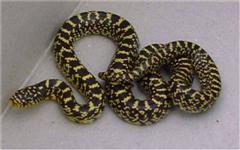Kingsnake - Desert
Desert King Snake Scientific Name: Lampropeltis getula splendida
Mon, 30th June, 2025 - 8:46 pm GMT
Sponsor Ads:

Alternative Name
Desert King Snake Scientific Name: Lampropeltis getula splendidaBasic Info
Desert Kingsnakes are usually shades of black and brown. They often have speckled markings in yellow, cream, or white. Hatchling Desert Kingsnakes are significantly brighter. The coloration fades with age. The Desert Kingsnake is a moderately sized snake and is rarely seen over four feet in length, although some specimens have been longer than five feet.
Health
The ambient temperature within the enclosure should be about 80 degrees Fahrenheit, with a basking area in the mid to high 80s. At night the temperature should drop to about 75 degrees. The Desert Kingsnake should always have access to a large water bowl. The snake will not only drink out of this bowl but also soak and defecate in it, so it may need to be cleaned often. The bowl should be spill-proof. Kingsnakes will eat almost anything, they will even eat other snakes. For this reason they should be housed alone. Breeding Male Desert Kingsnakes can usually be distinguished from females by the thicker, heavier tails. They can also be probed to determine the sex. However, probing should only be done by professionals. Desert Kingsnakes can be bred when they are about three feet long. Prior to breeding, they should be brumated at between 50 and 65 degrees Fahrenheit for eight to twelve weeks. During the brumation period, they should not be fed, although water should always be available. After brumation, they should be offered food. For about two or three weeks, the snakes should be fed slightly more than usual. After bromating, the female will shed. It is directly after this shed that the female is most receptive to mating and should be introduced to the male. After breeding, the female sheds again. This occurs between five and eight weeks after breeding. It is at this time that the female will lay her eggs. Because female Kingsnakes often lay their eggs in water, the water dish should be removed and only offered to the snake once a day. The female will lay a clutch consisting of between 5 and 24 eggs, about seven days after she is finished shedding. After between 42 and 65 days of incubation at temperatures between 78 and 85 degrees Fahrenheit, the eggs will hatch.Habitat
Found primarily in the desert, as the name would suggest, the Desert Kingsnake can also reside near streams, ponds or rivers and on agricultural fields.Behavior
Desert Kingsnakes are found in arid regions of the Southwest United States and Northern Mexico. They are quite easy to keep in captivity and are relatively non-aggressive. While adapted to an arid climate, the Desert Kingsnake's population increases where water is present. The Desert Kingsnake is primarily diurnal, although they will venture out at night and remain in hiding during the day in very hot weather. They will eat almost anything and so are easy to feed in captivity. The Desert Kingsnake is not a very active animal, and they are quite secretive.Origin
North AmericaHistory
One of seven subspecies of Common Kingsnake, the Desert Kingsnake is found in western Texas, Arizona, and northern Mexico. They breed easily in captivity and so a wild caught specimen should not be bought. There are several laws in Texas and Arizona regarding the capture of wild Kingsnakes. Desert Kingsnakes are easy to care for in captivity.Common Foods
feeds on lizards, birds, snakes, eggs, frogs, lizards and small mammalsSponsor Ads:
Some people can look so busy that they seem indispensable. -- Unknown
Kingsnake - Desert
Coded by: BGID® | ALL RIGHTS RESERVED Copyright © 2000-2025
Disclaimer | Privacy | Report Errors / Contact | Credits
















